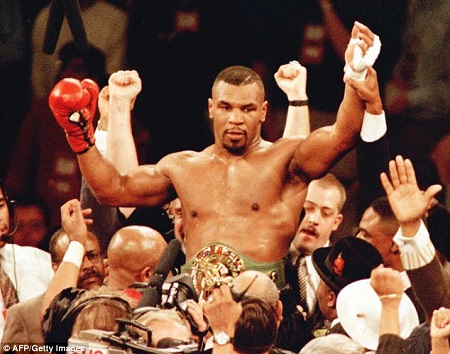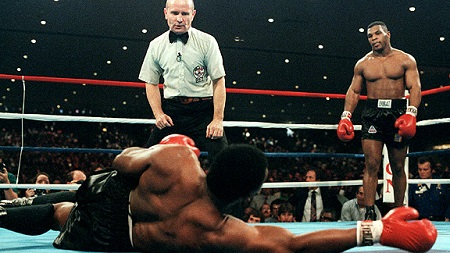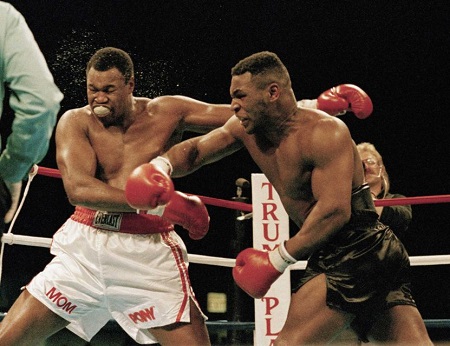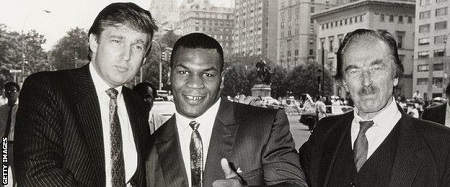Hot Stories
Recent Stories
Mike Tyson: Memories of a Magnificent Fighting Machine
Posted by Samuel on Mon 20th Mar, 2017 - tori.ngMike Tyson is considered to be one of the greatest heavyweight boxers of all time. This is a look into the life of the champ.

Tyson is lifted in the air after winning the WBC title after beating Frank Bruno in 1996
Mike Tyson arrived on the heavyweight scene like a great white beneath a crashing wave. Eyes that were dead but could drill right through you. And those teeth, straight out of Mack the Knife: “When that shark bites… scarlet billows start to spread.” Next, a body was usually dumped on the canvas, oozing life.
Tyson was what the boxing world had been waiting for since the demise of Sonny Liston two decades earlier. Three years after Liston’s death in 1970, the New York Times opined that heavyweight boxing missed his “frightening sense of evil”. American sports writer Bud Collins wrote: “Sonny is an ogre I miss.”
George Foreman – the early 1970s version who put holes in people, rather than the 1990s version who was like your grandad – briefly fitted the bill. But Muhammad Ali cast out the evil Foreman, just like he had cast out the evil Liston 10 years earlier. And when Ali belatedly hung them up, things got dull.
Larry Holmes was a former Ali sparring partner with some of his skills but little of his charisma. Between winning the world heavyweight crown in 1978 and losing it to Michael Spinks in 1985, Holmes forged a reputation as one of the most technically proficient champions in history and one of the least inspiring.
While Holmes reigned, for the most part serenely, the promoter Don King – a man Holmes once described as “hating fighters” – took ownership of the heavyweight crown, as revealed by investigative journalist Jack Newfield in his book, The Life and Crimes of Don King.

Mike Tyson’s defeat of Trevor Berbick in 1986 made him the youngest world heavyweight champion in history
After Michael Dokes, whom King had likened to a son, lost his WBA title to South Africa’s Gerrie Coetzee in 1983, King stepped over his prone body to embrace the new champion. Dokes fell further into cocaine addiction and a few years later was reduced to begging King for money, apparently to no avail.
But the fight that best defines the era was between Tim Witherspoon and Greg Page in 1984. Despite the match being for the vacant WBC belt, Page was so demoralised by King’s treatment that he barely trained. After Witherspoon was awarded a contentious decision, Holmes, who had vacated the title, commented that he had seen more action watching old ladies play the slot machines.
When Witherspoon returned to King’s training camp, money was so scarce and the mood so low, the champion tried to start a revolt. Other fighters in the camp included former world champion Leon Spinks and future Tyson opponents Mitch Green, Pinklon Thomas and Trevor Berbick, also the last man to fight Ali. But there was so much weed being smoked, they couldn’t get motivated.
Witherspoon thought his world title defence against Frank Bruno would finally make him a millionaire. But after King had made the ‘necessary’ deductions from his purse, Witherspoon was left with $90,000. Bruno, despite being the challenger and knocked out in the 11th round, walked away with $900,000.
When Witherspoon was knocked out in one round by James Smith in his next fight, he was simply relieved that King was out of his life. A couple of weeks later, he was served with an eviction notice after failing to pay rent.
As the heavyweight scene stagnated, boxing fans got their fixes from the lower weight divisions. The sport was kept alive by the ‘Four Kings’ – Marvin Hagler, Sugar Ray Leonard, Thomas Hearns and Roberto Duran – who staged a round-robin of thrilling fights that further highlighted the sad state the big boys were in. And then came Tyson, the heavyweight ogre everyone had been missing.

Mike Tyson, right, follows through on a punch to Larry Holmes in 1988
Tyson’s defeat in the 1984 Olympic trials was broadcast live on television. He turned pro at the start of 1985, during which he racked up 15 victories, all by knockout, 11 of them in the first round. It was around about this time that the Jaws music kicked in, and the various alphabet champions began to get twitchy.
After a horrific childhood in some of the more unsavoury neighbourhoods of New York, Tyson was taken under the wing of venerable boxing trainer Cus D’Amato, who had guided Floyd Patterson to the world heavyweight title twice.
D’Amato must have seen plenty of Liston in his protege, because Liston, who knocked Patterson out twice in one round, was also a criminal since childhood.
D’Amato became Tyson’s legal guardian, attempted to keep him on the straight and narrow (while occasionally having to smooth things over with the police) and moulded him into a vicious fighting machine. And when D’Amato died in November 1985, Tyson carried on doing what he did best – making life ooze.
Tyson made his television debut as a pro in February 1986, against a decent prospect called Jesse Ferguson. The 19-year-old had already appeared on the cover of Sports Illustrated and before he entered the ring – minus the traditional robe and wearing short black shorts and no socks – the crowd was in raptures.
In a ring that resembled a phone box, Tyson tenderised Ferguson like a lump of meat. After a sixth-round stoppage, Tyson described the uppercut that had floored Ferguson in the fifth: “I tried to catch him on the tip of the nose, because I tried to punch the bone into his brain. I didn’t want him to last.”
While Liston’s “frightening sense of evil” was too pungent for many in the more innocent early ’60s, contemporary boxing fans couldn’t get enough of Tyson. A 5ft 11in, 220lb, bull-necked slab of badness who kept pigeons. Quite wonderful.
Remarkably, at least by today’s standards, Tyson had fought 12 times in 1986 before landing a shot at Berbick’s WBC title in Las Vegas. The fight was part of an elimination tournament, designed to unify the three main world title belts, and Berbick sounded confident of victory: “I’m going to take him to school. I’m very relaxed. This is the best thing that’s ever happened to me.”

Everyone wanted to meet the ‘baddest man on the planet’, including Donald Trump and father Fred
It didn’t look like Tyson was learning much, as he wailed away on Berbick with crosses and hooks. Berbick didn’t look relaxed when a Tyson right hand sent him crashing to the canvas. And it didn’t look like the best thing to have happened to Berbick, as he collapsed onto some ringside photographers before attempting to get to his feet, staggering sideways and hitting the deck again.
Now the whole world knew it: Tyson was so mean, he could knock you down twice with one punch. And he could punch you drunk in under six minutes. And the kid was only 20, the youngest world heavyweight champion in history.
Writers anointed him the rightful heir to Johnson, Dempsey, Louis and Ali, but D’Amato’s fighting machine was already malfunctioning. Ever wondered why Tyson looked so angry that night? It might be because he was shot through with a dose of gonorrhoea that stung far more than anything Berbick threw at him.
The following July, Tyson outpointed Tony Tucker to become the first undisputed world heavyweight champion since 1978. In 1988, he stopped Holmes in four rounds, before disposing of Michael Spinks, another former champion, in one. Bruno followed in 1989, before it all came crashing down.
The Tyson that entered the ring against James ‘Buster’ Douglas in February 1990 was pitifully diminished by personal turmoil, his marriage having burnt out spectacularly in public and King having finally sunk his claws into him.
The sight of Tyson, scrabbling for his gumshield on his hands and knees as the referee counts him out is as pathetic in the memory as it was shocking at the time.
There followed a prison sentence for rape, the regaining of the world title, the night he lost it again, the night he bit off an ear, the loss of his fortune (likely to happen if you swap pigeons for Bengal tigers) and more sad nights in the ring.
But nothing that has happened since can erase the memory of what a magnificent fighting machine he was, way back when: coming at you like a great white shark, spreading scarlet billows, dumping bodies, oozing life.
-Culled from BBC
Top Stories
Stories from this Category
Recent Stories
















































